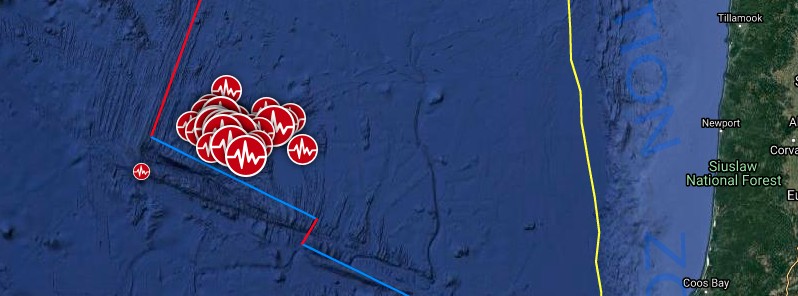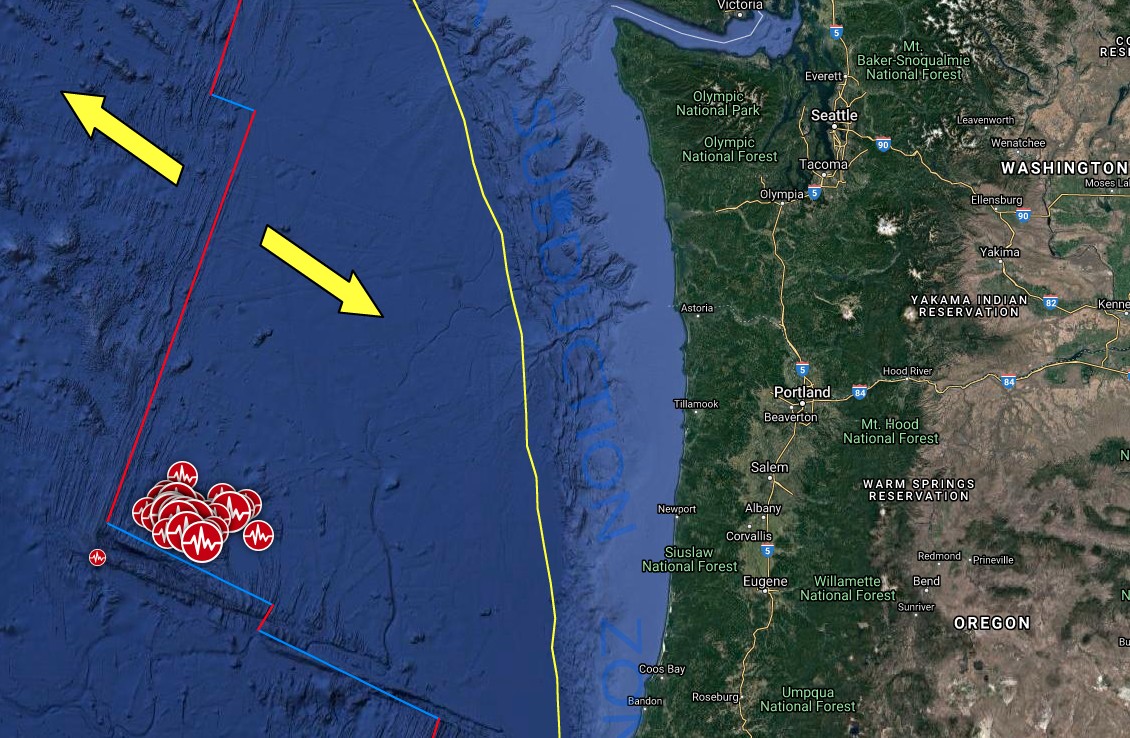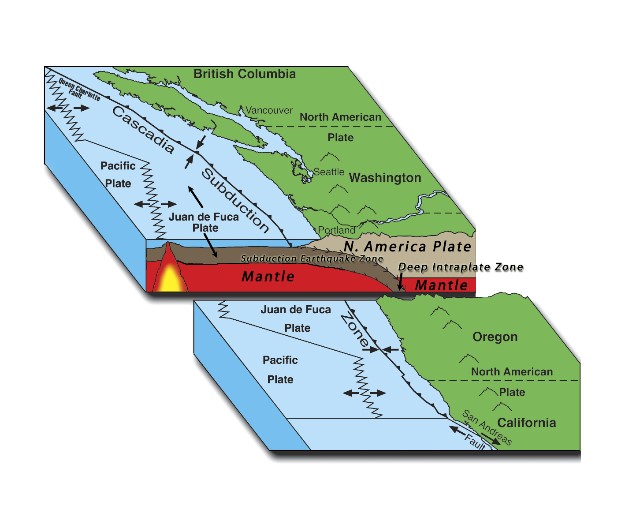Series of strong earthquakes hit off the coast of Oregon, U.S.

A series of earthquakes hit off the coast of Oregon, U.S. on December 7 and 8, 2021. The quakes are taking place at a shallow depth of about 10 km (6.2 miles), some 500 km (320 miles) W of Salem, Oregon.
The swarm, located about 360 km (200 miles) west of the Cascadia Subduction Zone, is ongoing along the Blanco Fracture Zone, which is a strike-slip fault system on the edge of the Juan de Fuca plate.
The series started with M4.2 at 13:21 UTC and continued through the morning.
By 07:36 UTC on December 8, the USGS registered 41 earthquakes (M3.4 – M5.8).
There are no people living within 100 km (62 miles).
The USGS issued a Green alert for shaking-related fatalities and economic losses. There is a low likelihood of casualties and damage.
According to the forecast made by the USGS, there is a 1% chance of one or more aftershocks that are larger than magnitude 5.8 over the next 7 days.1
The chance of an earthquake of magnitude 3 or higher is 97%, and it is most likely that as few as 0 or as many as 29 such earthquakes may occur in the case that the sequence is re-invigorated by a larger aftershock. The chance of an earthquake of magnitude 5 or higher is 9%, and it is most likely that as few as 0 or as many as 1 such earthquakes may occur. The chance of an earthquake of magnitude 6 or higher is 1 in 100, such an earthquake is possible but with a low probability. The chance of an earthquake of magnitude 7 or higher is 1 in 1 000, such an earthquake is possible but with a low probability.
"Earthquakes in this region often come in swarms similar to this one," the USGS said.
"The largest event within 50 km (31 miles) of this swarm since 1995 was a M6.3 in January 2003 which was also part of a swarm that occurred over a ~24-hour period and included 4 other EQs of M5.1 – M5.7.
"Because these quakes are generally small to moderate in magnitude and have a strike-slip focal mechanism (lateral or horizontal motion, not vertical), they are unlikely generate tsunamis. However, if they become larger, they might cause some increased local waves.
"This swarm is unlikely to trigger a significant EQ in the Cascadia subduction zone given the magnitude of the EQs in the swarm & their distance from the subduction zone. Similar previous swarms in this region have not triggered significant EQs in the Cascadia subduction zone."

Image credit: TW/SAM, Google
Currently, scientists are predicting that there is about a 37% chance that a megathrust earthquake of 7.1+ magnitude will happen at the boundary between the Juan de Fuca and North American plates, called the Cascadia Subduction Zone, in the next 50 years. This event will be felt throughout the Pacific Northwest.2
The Cascadia Subduction Zone is a ~1 000 km (600 miles) long fault that runs from northern California up to British Columbia and is about 100 – 160 km (70 – 100 miles) off the Pacific coast shoreline.
There have been 41 earthquakes in the last 10 000 years within this fault that have occurred as few as 190 years or as much as 1 200 years apart.
The last earthquake that occurred in this fault was on January 26, 1700, with an estimated magnitude of 9.0. This earthquake caused the coastline to drop several feet and a tsunami to form and crash into the land.
What is most surprising is that evidence for this great earthquake also came from Japan. Japanese historic records indicate that a destructive distantly-produced tsunami struck their coast on January 26, 1700. By studying the geological records and the flow of the Pacific Ocean, scientists have been able to link the tsunami in Japan with the great earthquake from the Pacific Northwest. Native American legends also support the timing of this last event.

Image credit: Oregon.gov
Oregon has the potential for a 9.0+ magnitude earthquake caused by the Cascadia Subduction Zone and a resulting tsunami of up to 30 m (100 feet) in height that will impact the coastal area. There is an estimated 2 – 4 minutes of shaking or rolling that will be felt along the coastline with the strength and intensity decreasing the further inland you are.
The Cascadia Subduction Zone has not produced an earthquake since 1700 and is building up pressure where the Juan de Fuca Plate is subsiding underneath the North American plate.
References:
1 M5.8 – off the coast of Oregon – Aftershocks forecast – USGS
2 Cascadia Subduction Zone – Oregon.gov
Featured image credit: TW/SAM, Google

A tectonic plate is dying under Oregon. Here’s why that matters.
https://www.nationalgeographic.com/science/article/tectonic-plate-dying-oregon-why-matters
Tension causes stress while pressure is a compression force, the opposite of tension. Why do you need a thesaurus to understand basic physics, such as I learnt in high school?
The Juan de Fuca plate is nothing to do with what happens elsewhere on the west coast, that being a subduction zone with the Pacific Oceanic Plate diving underneath the American plate. Juan de Fuca is a much older plate.
You can easily read about it here instead of giving Teo a hard time.:
https://www.usgs.gov/media/images/subduction-juan-de-fuca-plate-beneath-north-american-pla
The Juan de Fuca plate
DEAR Mike Thomas;
Your comment was attention getting – and I appreciate your effort. Perhaps using a SYNONYM THESAURUS would help you discern material differences in words which you could then explain. Aren’t the words “stress – tension – pressure” very similar? Perhaps if you had described the subtle geological differences in these words I would have been able to follow your comment.
Cascadia subduction zone doesn’t build pressure, creates tension between Juan de Fuca plate and the North American Plate in this case while the first sinks under, dragging most of that section from Canada to West US Coast mainland up and backwards, the process create stress in rocks till they fail thus an earthquake, you should check where you get your science from, it’s just awful.
THANK YOU FOR YOUR DETAILED DESCRPTION OF EARTHQUAKES OFF THE COAST OF OREGON. JUST A NOTE: Salem is EAST of these quakes – not west.